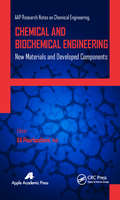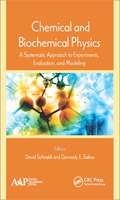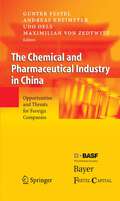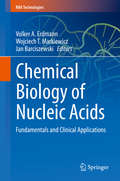- Table View
- List View
Chefsache Gesundheit II: Der Führungsratgeber fürs 21. Jahrhundert (Chefsache)
by Peter BuchenauDas Buch ist eine Fortsetzung des bereits bei Springer Gabler erschienenen ersten Bandes Chefsache Gesundheit. Neue Autoren führen das Thema weiter fort. Der demografische Wandel und ein damit verbundener Mangel an leistungsfähigen Führungs- und Fachkräften, der stete Druck, sich an einem globalisierten Markt zu beweisen, die immer komplexer werdenden Prozesse der internen Administration – all dies stellt Unternehmen und Mitarbeiter vor enorme Herausforderungen. Umso wichtiger wird es in diesem Zusammenhang, die wertvolle Ressource Mensch zu schützen und dessen Arbeitskraft zu erhalten. Gesundheit spielt hierbei eine große Rolle: Gesunde Mitarbeiter leisten mehr, sind produktiver und effektiver. Gesundheit wird zur Chefsache und zum Wirtschaftsfaktor in Unternehmen, wie es auch der kommende sechste Kondratieff-Zyklus vorsieht. 14 Coaches, Berater und Trainer beschreiben bezogen auf ihr jeweiliges Fachgebiet, welchen Einfluss der Faktor Gesundheit künftig auf Unternehmen haben wird, und geben praktische Hinweise für einen zeitgemäßen Umgang mit diesem wichtigen Thema.
Cheirolumbar Dysostosis: Developmental Brachycheiry and Stenosis of the Bony Vertebral Lumbar Canal
by A. WackenheimIt was with great pleasure that I accepted Professor Wackenheim's invitation to write the preface of this most interesting monograph. During the international course on neuroradiology in Obernai, organized by Professor Wackenheim in 1978, an entire day was devoted to discussions about various aspects of stenosis of the lumbar vertebral canal. As Professor Wackenheim and his group, in particular Dr. E. Babin, had thorough· ly studied this field, it was an excellent occasion for the exchange of views through personal contact. Their support of basic views such as attributing the cause of stenosis to a developmental disturbance of growth of the neural element - the vertebral arc- and spontaneous agreement about essentials in classification and nomenclature facili tated this exchange. Reading the present monograph made me think back to 1949 when I wrote my first publication on stenosis of the lumbar vertebral canal in a French volume that com memorated my teacher in neurosurgery, Professor Clovis Vincent. During the following years it was impossible to publish a more detailed paper on the subject in international journals since their editorial boards did not believe in its occurrence. My first English papers were published in the Journal of Bone and Joint Surgery (1954, 1955), but it was only during the 1970s that this form of stenosis became more universally recog nized.
Chemical Anatomy of the Zebrafish Retina: (pdf)
by David Cameron Robert E. Marc Keith M. Studholme Stephen YazullaChemical and Biochemical Engineering: New Materials and Developed Components
by Ali Pourhashemi Gennady E. Zaikov A. K. HaghiThis book facilitates the study of problematic chemicals in such applications as chemical fate modeling, chemical process design, and experimental design. This volume provides comprehensive coverage of modern biochemical engineering, detailing the basic concepts underlying the behavior of bioprocesses as well as advances in bioprocess and biochemic
Chemical and Biochemical Physics: A Systematic Approach to Experiments, Evaluation, and Modeling
by David Schiraldi Gennady E. ZaikovWritten by highly regarded experts in the field, this book covers many of the major themes of chemical and biochemical physics, addressing important issues, from concept to technology to implementation. It provides new research and updates on a variety of issues in physical chemistry and biochemical physics. Many chapters include case studies and s
Chemical and Biological Aspects of Steroid Conjugation
by S. Bernstein S. SolomonThis book represents a collaborative endeavor by a group of investigators to bring together in a single volume a critical discussion of the major facets of our knowledge, ranging from chemical to clinical aspects, of steroid conjugation. However, the important field of bile acid and bile alcohol conjugation has been discussed only superficially since it was decided arbitrarily to be outside the projected scope of the book. The reader is referred to the companion volume of this book, namely Physical Properties of Steroid Conjugates (by Bernstein, Dusza, and Joseph, Springer-Verlag New York 1968), for complemental information on individual conjugates. The Editors wish to thank Miss Elise Kramer for typing assistance. Also we wish to express our deep appreciation and gratitude to Mrs. Dorothy Budd, our copy-editor, and Mr. J. Joseph for their editorial assistance in making this book possible. SEYMOUR BERNSTEIN Pearl River, N. Y. January, 1970 SAMUEL SOLOMON V11 CONTENTS Preface . . . . VII Nomenclature a, Discussion of Nomenclature System x b, Trivial and Systematic Names. x List of Contributors . . . . . . . . Xl Chemistry: Synthesis and Characterization S. BERNSTEIN, 1. P. DUSZA, and J. P. JOSEPH Enzymological Aspects of Steroid Conjugation A. B. Roy . . . . . . . . . . 74 The Hydrolysis of Steroid Conjugates H. L. BRADLOW . . . . . 131 Isolation of Steroid Conjugates P. K. SITTERI. . . . . . . 182 The Biochemistry of the 3P-Hydroxy-Ll5-Steroid Sulfates K. D. ROBERTS and S. LIEBERMAN 219 Formation, Metabolism, and Transport of Estrogen Conjugates E. DICZFALUSY and M. LEVITZ. . . . . . . . . . . . .
Chemical and Cellular Architecture
by N. S. Abel LajthaAfter the completion of the first edition of this series, this editor thought that a new edition would not be warranted in less than IS, perhaps 20, years, but it seems that we live in a time in which rapid changes are the norm and findings in a field such as neurochemistry develop exponentially. The task of a future editor attempting to get a comprehensive neurochemical handbook for the year 2000 would be even less enviable, but by then information processing may be very different. The approach, the design, and the areas covered by each volume and each chapter are necessarily arbitrary, and it is likely that other editors or authors would have approached the coverage or the organization in a different manner. It is hoped, however, that readers will find the series helpful for beginning or for continuing work. There may be some overlap among the various chapters, but insisting on single coverage of an area would at times have restricted treatment to only one point of view and might have truncated and hurt the logical flow of some of the chapters.
Chemical and Functional Genomic Approaches to Stem Cell Biology and Regenerative Medicine
by Sheng DingScientists believe that stem cells have the potential to revolutionize the treatment of numerous diseases and conditions. This guide covers recent advances in technologies and their applications in stem cell biology, addressing the use of both embryonic and adult stem cells and discussing diverse technologies, including genome-wide expression analysis, informatics, chemical genomics, and more. Applications covered encompass self-renewal, differentiation, reprogramming, and regeneration in model organisms. This is a premier reference for practicing professionals involved in stem cell research and students.
The Chemical and Pharmaceutical Industry in China: Opportunities and Threats for Foreign Companies
by G. Festel A. Kreimeyer U. Oels Maximilian Von ZedtwitzA detailed examination of China’s increasingly important chemical and pharmaceutical industry. Numerous case studies describe how western companies, such as BASF, Bayer, Bicoll, Ciba, Degussa, DSM and Novartis are managing their market entry in China.
Chemical and Pharmacological Perspective of Artemisia amygdalina (SpringerBriefs in Pharmacology and Toxicology #0)
by Shabir H. Lone Khursheed Ahmad Bhat Mohammad Akbar KhurooThis book reviews the chemical and biological properties of Artemisia amygdalina Decne, a critically endangered and endemic plant species in the the high-altitude Kashmir Himalayas, which has a high pharmacological potential. It describes the bioactivity-guided isolation of its chemical compounds, their characterization using spectroscopic methods and the development of a simple and reliable RP-HPLC method for the simultaneous quantification of the isolated constituents. The authors discuss the potential pharmacological activities of A. amygdalina, such as antioxidant, cytotoxic, anti-inflammatory, immuno-modulatory and antidiabetic effects, and pave the way for future research.
Chemical and Physical Behavior of Human Hair
by Clarence R. RobbinsNine years have elapsed since I wrote the first English edition of this book, and progress in hair science has made a second edition necessary. Since 1978, at least two new m~or scientific cosmetic journals have appeared, and four International Hair Science Symposia and one International Symposium on Forensic Hair Comparisons have been held. Thus, continuing studies in hair science have been numerous in the past nine years, so much so that a large proportion of the text had to be completely rewritten. In addition, a number of omissions that were kindly pointed out by reviewers have been included in this edition, as well as corrections sent to me by readers. I sincerely hope that this new edition fulfills the original purposes: to provide a reasonably up to date and complete account of the chemical and physical properties and behavior of human hair, and to serve as a convenient starting point for hair research-and, as indicated in the first edition, not to be the final word.
Chemical and Physical Behavior of Human Hair
by Clarence R. RobbinsHuman hair is the subject of a remarkably wide range of scientific investigations, and the third edition of this book confirms its position as the definitive monograph on the subject. The chemical and physical properties of hair are of importance to the cosmetics industry, forensic scientists, and biomedical researchers. As such, Chemical and Physical Behavior of Human Hair is both a teaching guide and a reference volume for cosmetic chemists and other scientists in the hair products industry, academic researchers studying hair and hair growth, textile scientists, and forensic specialists.
Chemical and Physical Behavior of Human Hair
by Clarence R. RobbinsHuman hair is the subject of a wide range of scientific investigations. Its chemical and physical properties are of importance to the cosmetics industry, forensic scientists, and to biomedical researchers. This updated and enlarged fourth edition continues the tradition of its predecessor as being the definitive monograph on the subject. It now contains new information on various topics including: chemical hair damage, the cause of dandruff, skin and eye irritation, hair straightening, and others. Chemical and Physical Behavior of Human Hair is a teaching guide and reference volume for cosmetic chemists and other scientists in the hair products industry, academic researchers studying hair and hair growth, textile scientists, and forensic specialists.
Chemical and Physical Behavior of Human Hair
by Clarence R. RobbinsHuman hair is the subject of a remarkably wide range of scientific investigations. Its chemical and physical properties are of importance to the cosmetics industry, forensic scientists and to biomedical researchers. The fifth edition of this book confirms its position as the definitive monograph on the subject. Previous editions were recognized as “concise and thorough” (Journal of the American Chemical Society), “an invaluable resource” (Canadian Forensic Science Society Journal), and “highly recommended” (Textile Research Journal). Chemical and Physical Behavior of Human Hair is a teaching guide and reference volume for cosmetic chemists and other scientists in the hair products industry, academic researchers studying hair and hair growth, textile scientists and forensic specialists.Features of the Fifth Edition: Recent advances in the classification and characterization of the different proteins and genes in IF and keratin associated proteins in human hair are described. The mechanism and incidence of hair growth and loss and hair density vs. age of males & females are described for Asians, Caucasians and Africans in different scalp regions. Details of hair surface lipids and cuticle membranes provide a better understanding of the surface and organization of the CMC and its involvement in stress strain is presented. Recent evidence demonstrates a more bilateral structure in curly hair and a more concentric arrangement of different cortical proteins in straighter hair. SNPs involved in hair form (curl and coarseness) and pigmentation and genes in alopecia and hair abnormalities are described. The latest biosynthetic scheme for hair pigments and structures for these and the different response of red versus brown-black pigments to photodegradation is described.A new method for curvature on 2,400 persons from different countries and groups is used to assign curvature throughout this book. Additional data for age and effects on diameter, ellipticity, elastic modulus, break stress and other parameters are presented with much larger data sets featuring statistical analyses.Hair conditioning, strength, breakage, split ends, flyaway, shine, combing ease, body, style retention, manageability and feel parameters are defined and described.A new section of different life stages by age groups considering collective and individual changes in hair fiber properties with age and how these affect assembly properties.
Chemical and Physical Signatures for Microbial Forensics (Infectious Disease)
by John B. Cliff, Helen W. Kreuzer, Christopher J. Ehrhardt and David S. WunschelCombining the disciplines of biological, physical and chemical science, microbial forensics has a rapidly rising profile in a world increasingly troubled by the threat of ‘biocrime’ and ‘bioterrorism’. This valuable resource is a major addition to a body of literature reckoned to lack sufficient breadth. It presents a variety of phenotypic and trace signature methodologies associated with cultured microorganisms that, despite being genetically identical, may be characterized by differing cultural environments. One of the central challenges faced by those working in this field is the sheer diversity of potentially harmful agents, which in themselves total more than 1000 viruses, bacteria, fungi and protozoan parasites. Their numerous additional variants render the process of ‘fingerprinting’ biological agents notoriously difficult, especially when the limitations of genetic analysis are factored in. Attribution of crime is relatively easy through human DNA, but lacking the genetic individuation of humans and animals, microbial forensics has to complement phylogenetic techniques with chemical and physical ones. In the best case, genetic analysis in the ‘biocrime’ sector can exclude sources, narrow the population of possible sources and support associations with potential sources. To complement these genetic techniques, chemical and physical methods can be used to compare ‘signatures’ imparted to microbial samples by environments in which they are grown and processed. Collating a range of microbiological fingerprinting techniques in one volume, and covering everything from statistical analysis to laboratory protocols, this publication furthers the aim of forensic investigators who need robust and legally admissible forensic evidence to present in a courtroom.
Chemical and Structural Approaches to Rational Drug Design
by David B. Weiner; William B. WilliamsThis book is the first to provide both a broad overview of the current methodologies being applied to drug design and in-depth analyses of progress in specific fields. It details state-of-the-art approaches to pharmaceutical development currently used by some of the world's foremost laboratories. The book features contributors from a variety of fields, new techniques, previously unpublished data, and extensive reference lists.
Chemical and Structural Approaches to Rational Drug Design
by David B. Weiner William V. WilliamsThis book is the first to provide both a broad overview of the current methodologies being applied to drug design and in-depth analyses of progress in specific fields. It details state-of-the-art approaches to pharmaceutical development currently used by some of the world's foremost laboratories. The book features contributors from a variety of fields, new techniques, previously unpublished data, and extensive reference lists.
Chemical Architecture of the Nervous System
by Abel LajthaLife, either as we think of it in the abstract in its highest sense, or life, as we think of it in terms of a compact living organism, is obviously the result of complex interaction of all of the components of the organism. One could therefore question the advisability of separating out the nervous system for a special detailed study in our age of overspecialization. The main purpose of the present Handbook is not to fragment further our approach or under standing of living phenomena, but, on the contrary, to try to summarize and integrate as much of the available information and thinking on the nervous system as is possible in a limited space. It is difficult to think of an area of modern biology that is more exciting to study and that has greater impor tance for mankind, from any point of view, than the study of the brain and of the nervous system. The influence that understanding of brain function in biological terms can exert on our future is not generally understood in its full impact. Although our ignorance about even the most basic mechanisms in the nervous system is enormous, in recent years our knowledge has made most important advances, and as a consequence great masses of data have been accumulated.
Chemical Biology: and Drug Discovery
by Marco F. SchmidtThe focus of this textbook is on application, rather than pure knowledge transfer of the results of all chemical biological work (which would also be beyond the scope of a book). It gives the reader, through the specific selection of chemical biological techniques and concepts, the necessary tools to be able to develop new ways of thinking and thus new therapeutic options in the complex field of chemical biology and drug development. The stated aim of this book is to provide concrete solutions and inspiration to students, (post)graduate students, and experienced scientists at universities as well as in industry in their problems. After an introduction to the problems addressed by chemical biology in drug discovery, the three levels of molecular biology dogma: DNA, RNA and proteins and their role as drug targets serve as the common thread of this book.This book is a translation of the original German 1st edition Chemische Biologie by Marco F. Schmidt, published by Springer-Verlag GmbH Germany, part of Springer Nature in 2020. The translation was done with the help of artificial intelligence (machine translation by the service DeepL.com). A subsequent human revision was done primarily in terms of content, so that the book will read stylistically differently from a conventional translation. Springer Nature works continuously to further the development of tools for the production of books and on the related technologies to support the authors.
The Chemical Biology of Long Noncoding RNAs (RNA Technologies #11)
by Jan Barciszewski Stefan JurgaThis book offers a comprehensive and detailed overview of various aspects of long non-coding RNAs. It discusses their emerging significance in molecular medicine, ranging from human cancers to cardiovascular and metabolic diseases. Transcriptomic studies have demonstrated that the majority of genomes found in complex organisms are expressed in highly dynamic and cell-specific patterns, producing huge numbers of intergenic, antisense and intronic long non-protein-coding RNAs (lncRNAs). Thousands of lncRNAs have been identified, and unlike mRNA, they have no protein-coding capacity. A large repertoire of ncRNAs, actively transcribed from the mammalian genome, control diverse cellular processes, both in terms of development and diseases, through a variety of gene regulatory mechanisms. IncRNAs have emerged as a new paradigm in epigenetic regulation of the genome. Given its scope, the book will be of particular interest to molecular, chemical, cell and developmental biologists, as well as specialists in translational medicine involved in disease-oriented research. It also offers a valuable resource for in silico experts seeking a deeper understanding of lncRNA expression and function through computational analysis of the NGS data.
Chemical Biology of Natural Products
by David J. Newman Gordon M. Cragg Paul GrothausChemical Biology of Natural Products This unique, long-awaited volume is designed to address contemporary aspects of natural product chemistry and its influence on biological systems, not solely on human interactions. The subjects covered include discovery, isolation and characterization, biosynthesis, biosynthetic engineering, pharmaceutical, and other applications of these compounds. Each chapter begins with a brief and simple introduction to the subject matter, and then proceeds to guide the reader towards the more contemporary, cutting-edge research in the field, with the contributing authors presenting current examples from their own work in order to exemplify key themes. Topics covered in the text include genome mining, heterologous expression, natural product synthesis, biosynthesis, glycosylation, chemical ecology, and therapeutic applications of natural products, both current and potential.
Chemical Biology of Natural Products
by David J. Newman Gordon M. Cragg Paul G. GrothausChemical Biology of Natural Products This unique, long-awaited volume is designed to address contemporary aspects of natural product chemistry and its influence on biological systems, not solely on human interactions. The subjects covered include discovery, isolation and characterization, biosynthesis, biosynthetic engineering, pharmaceutical, and other applications of these compounds. Each chapter begins with a brief and simple introduction to the subject matter, and then proceeds to guide the reader towards the more contemporary, cutting-edge research in the field, with the contributing authors presenting current examples from their own work in order to exemplify key themes. Topics covered in the text include genome mining, heterologous expression, natural product synthesis, biosynthesis, glycosylation, chemical ecology, and therapeutic applications of natural products, both current and potential.
Chemical Biology of Nucleic Acids: Fundamentals and Clinical Applications (RNA Technologies)
by Volker A. Erdmann Wojciech T. Markiewicz Jan BarciszewskiThis volume contains 29 engrossing chapters contributed by worldwide, leading research groups in the field of chemical biology. Topics include pre-biology; the establishment of the genetic code; isomerization of RNA; damage of nucleobases in RNA; the dynamic structure of nucleic acids and their analogs in DNA replication, extra- and intra-cellular transport; molecular crowding by the use of ionic liquids; new technologies enabling the modification of gene expression via editing of therapeutic genes; the use of riboswitches; the modification of mRNA cap regions; new approaches to detect appropriately modified RNAs with EPR spectroscopy and the use of parallel and high-throughput techniques for the analysis of the structure and new functions of nucleic acids. This volume discusses how chemistry can add new frontiers to the field of nucleic acids in molecular medicine, biotechnology and nanotechnology and is not only an invaluable source of information to chemists, biochemists and life scientists but will also stimulate future research.
The Chemical Biology of Thrombin
by Roger L. LundbladThis book is a comprehensive review of thrombin, especially as regulatory protease. The ready availability of highly purified thrombin has stimulated rapid advances in the cell biology of this important macromolecule. The text focuses on research findings from the discovery of thrombin by Andrew Buchanan in 1842 to the present. A substantial amount of this work was conducted by the author and his colleagues. His work on the purification of thrombin was seminal to much subsequent work on thrombin. This volume provides a framework for future studies now made possible by the discovery of the importance of exosites in the physiology of thrombin function. The current work describes the process of the development of an oral inhibitor of thrombin used in the prevention of thrombosis. Key Features Reviews the history of Thrombin (Fibrin Ferment) Documents the relation of protein engineering and chemical modification in the study of thrombin Summarizes the interaction of thrombin with fibrinogen and fibrin Outlines the role of exosites in thrombin function Describes the development of an oral inhibitor for thrombin
The Chemical Biology of Thrombin
by Roger L. LundbladThis book is a comprehensive review of thrombin, especially as regulatory protease. The ready availability of highly purified thrombin has stimulated rapid advances in the cell biology of this important macromolecule. The text focuses on research findings from the discovery of thrombin by Andrew Buchanan in 1842 to the present. A substantial amount of this work was conducted by the author and his colleagues. His work on the purification of thrombin was seminal to much subsequent work on thrombin. This volume provides a framework for future studies now made possible by the discovery of the importance of exosites in the physiology of thrombin function. The current work describes the process of the development of an oral inhibitor of thrombin used in the prevention of thrombosis. Key Features Reviews the history of Thrombin (Fibrin Ferment) Documents the relation of protein engineering and chemical modification in the study of thrombin Summarizes the interaction of thrombin with fibrinogen and fibrin Outlines the role of exosites in thrombin function Describes the development of an oral inhibitor for thrombin





















